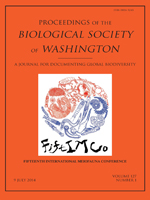Meiofauna refers to small benthic and interstitial organisms that pass through a 500 (1000) μm sieve and are retained on a 44 μm (or 63, 31 μm, depending on authors) sieve (Giere 2009). The majority of recognized phyla have meiofaunal representatives. Nematodes are predominant in most bottom habitats, and harpacticoid copepods and foraminiferans are secondarily dominant in many environments. Introductions on meiofauna are given in Higgins & Thiel (1988) and Giere (2009).
The International Association of Meiobenthologists (IAM) publishes a biannual newsletter, Psammonalia, and sponsors a triennial international conference. Psammonalia is published in June and December. The first issue of Psammonalia was published 10 November 1966 and was two pages long, and recently, No. 160 of Psammonalia was published in December 2013 (IAM 2014).
The purpose of meiofauna conferences has always been to gather researchers from around the world to share and discuss the taxonomy and ecology of meiofauna. The first meiobenthologists' international meeting dates back to July of 1969, when 28 researchers gathered at Tunis, Tunisia. At that time the organization was called the “Association of Meiobenthologists,” but the name was changed to “International Association of Meiobenthologists” in 1976 (IAM 2014). The community of meiofauna researchers grows with each conference, bringing together more enthusiasts to share their knowledge of the meiobenthos, and the conference reached its fifteenth meeting in 2013 (Table 1).
Table 1.
Venues of International Meiofauna Conferences.

The Fifteenth International Meiofauna Conference (FiftIMCo) was held in Korea, marking the first time the conference was held in Asia. “Biodiversity of Meiofauna” was the slogan for the FiftIMCo. More than 120 meiofauna enthusiasts from around the world attended the conference. A preconference workshop was held on 15–20 July 2013 at Yeosu, Chonnam National University, and the main conference was held on 22–26 July 2013 at Ansan, Hanyang University.
The conference was divided into ten different sessions, covering a variety of topics related to the study of the meiobenthos. Morphology and evolution of meiofauna, diversity and distribution of ostracods, frontiers and advances in foraminiferal research, meiofauna in particular aquatic habitats, and meiofauna in coastal waters are only a few of the many exciting topics the conference included. Special keynote speakers were invited to discuss the future of meiofaunal research. The conference included abstracts for 68 oral presentations and 69 abstracts for poster presentations from 120 participants from 24 nations.
This special issue of the Proceedings of the Biological Society of Washington is dedicated to the “Fifteenth International Meiofauna Conference (FiftIMCo)” and contains 18 selected papers in two sections: I) “Biodiversity of Meiofauna” with ten papers, and II) “Invertebrate fauna from Korea” with eight papers. The papers presented in this issue represent the first collective publication of proceedings of a meeting of the International Meiofauna Conference since its inception in 1969. As a co-editor of this special issue, I genuinely acknowledge all reviewers' efforts and assistance through the review process of the submitted manuscripts, the contributors of the papers, and the participants of FiftIMCo. I express my sincere and special thanks to the leadership of IAM, Drs. Nikolaos Lampadarious (Chairperson in 2011–2013), Ann Vanreusel, Jyotsna Sharma, Vadim Mokievsky, Jeffrey Baguley, John Fleeger, and Paul Montagna, and to Drs. Andrea Schmidt-Rhaesa, Martin V. Sørensen, Federica Semprucci, Jiang-Shiou Hwang, Fabrizio Frontalini, Alexey A. Kotov, and Dae-Yeon Moon for their help and efforts during the conference and the editing process of this special issue. I also appreciate deeply the local organizing committee, Drs. Ho-Young Soh, Cheon Young Chang, Tomislav Karanovic, Joo Lae Cho, Dong-Sung Kim, Hyun Soo Rho, Won-Gi Min, Sung Joon Song, Ivana Karanovic, Suk Hyun Youn, Kang Hyun Lee, and Jinwook Back, and the staff and students of my laboratory in Hanyang University: Drs. Eun-Ok Park, Hyungi Jeong, and Yeowon Kim, Hyun Ju Seo, Kichoon Kim, Jungho Hong, Seunghan Lee, Donggu Jeon, Hyunggeun Kim, Sangjin Kim, Hyunsu Yoo, Jeongho Kim, Raehyuk Jeong, Eunji Tak, Madhuri Saindane, and Vinod Lyons. This issue is supported partially by a grant “Discovery of indigenous species in Korea [Invertebrates except for insects, Part II]” to Wonchoel Lee from NIBR (National Institute of Biological Resources, Korea) and Marine Act Company.





